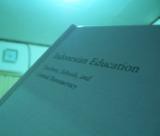The problem of teacher-bureucrats
Indonesian Education is an account of how school-based actors respond to central government’s policy to decentralize education that began in early 1990s. However, Christopher Bjork uses this account to explain something broader that, at first glance, seems trivial: The way Indonesian teachers frame their professional responsibilities.

Indonesian Education: Teachers, Schools, and Central Bureaucracy
by Christopher Bjork ▪ New York and London: Routledge, 2005 ▪ xv+185 pages
by Christopher Bjork ▪ New York and London: Routledge, 2005 ▪ xv+185 pages
Indonesian Education is an account of how school-based actors respond to central government's policy to decentralize education that began in early 1990s. However, Bjork uses this account to explain something broader that, at first glance, seems trivial: The way Indonesian teachers frame their professional responsibilities.
For most people, it is obvious that a teacher's professional responsibility is to teach. But this was not what Bjork found on his visits. "From campus after campus, teachers displayed a remarkably casual attitude toward their instructional duties. Yet most schools' employees displayed great seriousness towards school rituals." (p. xiv) This puzzled him.
So he decided to spend more than a year in late 1990s Malang observing six junior high schools (SMPs) -- public, private and religious. He interviewed principals and teachers, observed instructions at the back of classrooms, and hung around the teachers' offices. The result is a dense description of the environment that most Indonesian teachers must face – and clues to solving his puzzle.
He found one of these clues in history. The New Order saw schools as a crucial link to national integration. Thus, schools became a "powerful means to forge nationalistic loyalties and identities over ethnic, religious, and class division", and through schools, "a uniform national ideology, view of history, and a set of values" were communicated to Indonesian citizens.
As such, the Soeharto government went to great length to ensure ideological uniformity – among others, through the way curricula are interpreted.
In years immediately after independence, teachers had great leeway to interpret the broad guidelines outlined by the [Ministry of Education and Culture]; during the 1970s, in contrast, teachers were `increasingly burdened by more syllabus subjects, more detailed curricula, more numerous instructional objectives. (Schaeffer, 1990: 80)' (p. 53)
A heavy emphasis was put on obedience and loyalty in schools. For instance, principals rated their teachers based on criteria such as loyalty, work performance, obedience, honesty, cooperation and initiative. For all of these criteria, 75 was the passing grade – bar one: loyalty, in which a teacher had to achieve a score of 90 to continue working in any school.
All of these criteria, Bjork argues, indicated to teachers that their primary responsibility is to support the objectives set by the "center" in Jakarta. They reinforced the notion that "teachers are valued for their willingness to serve the government, not their skills as educators" (p. 95) – something that was confirmed by the tacit requirements for public school teachers to join the Indonesian Civil Servants Corps (Korpri) and vote for the ruling Golkar party.
Instead of being mere teachers, educators were expected to become teacher-cum-bureaucrats. Bjork compellingly illustrates how, on many occasions, the bureaucrat identity trumps that of a teacher.
Teachers, for instance, would make sure to come on time for the flag ceremony, yet would stop a lesson and leave for no apparent reason. The excitement that arose during a teachers meeting to prepare a celebration would be absent when the meeting's subject was teaching and the new curriculum. There were exceptions, of course, but the examples above proved to be the rule.
This mentality, Bjork argues, was also responsible for the failure of the much-hyped Local Content Curriculum (LCC) policy of the early 1990s. The central government, keen to follow the global trend of education decentralization, allowed – even required – school administrators to devote 20 percent of instructional hours for locally designed curriculum. This greater freedom did not move teachers to experiment with the curriculum. Instead, they simply relabeled existing courses "LCC courses".
Why was there little enthusiasm for this policy, despite the fact that it was uniformly considered good on paper?
According to Bjork, there is that teacher-bureaucrat mentality on the one hand: "Teachers in Indonesia do not cast themselves in the role of change agent; they do not even audition for the part... The instructor's role as a civil servant was emphasized over that of educator, and his opportunities to shape school policy and practice were limited. Obedience rather than initiative was rewarded." (p. 110)
On the other hand, officials often fail to grasp that education decentralization is not merely a technical process, but a process that demands drastic institutional changes. "Decentralization," suggests Bjork, "requires a change in institutional culture, but the [Ministry of Education and Culture] is only addressing the technical aspects of this process." (p. 172)
Until now, the hype of education decentralization remains. In its last incarnation, it comes under the name "school-based management". Failures of the past do not suggest that it will fail this time around. But they do suggest that something clearly needs fixing.
For success, Bjork argues that "government employees at both central and local levels must be firmly committed to the ideals that underpin decentralization, and lend adequate material and logistical support to reform efforts."
Alas, judging from the recent national exam controversy, one is left to wonder whether these commitments are indeed there.




0 Comments:
Post a Comment
<< Home